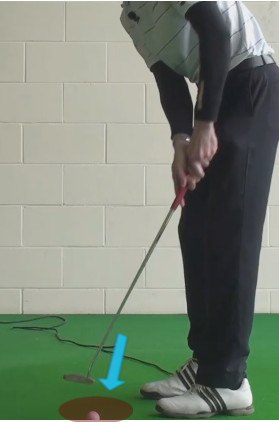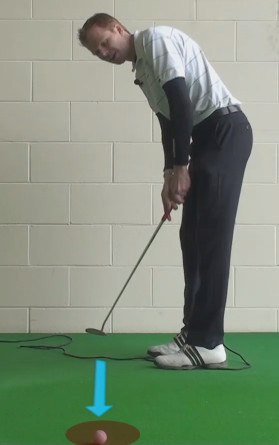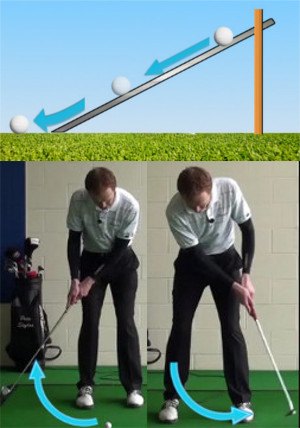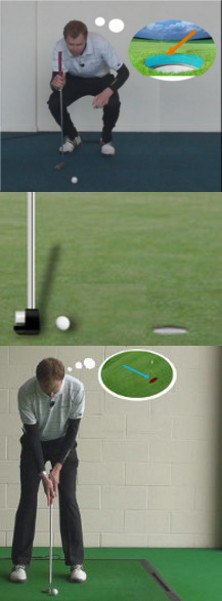
While no putting green is perfectly flat, some feature split levels, called tiers. These usually come in the form of two-tiered greens, but you'll occasionally encounter a green with three distinct levels.
Multi-tiered greens can be intimidating when putting from one tier to another. The slope that divides tiers can be several inches to as much as two feet or higher, complicating the task of getting the proper speed.
When putting from one level to another, the primary goal is to get ball onto the tier where the hole is located. Fail this and you'll face the same difficulty on the next attempt, and have a tough time two-putting. Therefore, speed is more important than line.
Approach uphill putts on two-tiered greens with these thoughts:
- Pick a spot that's a foot or two onto the top tier and get a feel for how hard you must hit the ball to reach it.
- Add the amount of hit needed to get from the spot to the hole.
- The ball should reach the dividing slope with just enough speed to topple over it, as the ball will gain considerable speed when rolling down the slope.
- To make sure you reach the lower level, hit the ball a little harder than you think is necessary to reach the edge of the dividing slope.

When putting to a lower tier:

Best Way to Putt Two-Tiered Greens
You already know that putting is an important part of the game of golf. Simply judging by the fact that you are reading a golf instruction article, it is nearly certain that you take your game pretty seriously. And, if you take the game seriously, you know that you have to putt well if you are going to post good scores. The typical amateur golfers largely ignores his or her putting, but you know better. By focusing on your putter while the rest of the players at your club hit balls on the range, you will quickly rise through the ranks.
In this article, we are going to talk about one specific area of putting which will come up from time to time – putting on two-tiered greens. A two-tiered green is a putting surface which has two unique levels. Sometimes, you will even find a multi-tiered green, where there are three or more levels to deal with. It is easy to understand how this kind of design feature can make putting extremely difficult. It is hard enough to judge your line and slope when putting on a typical slope – it can be nearly impossible when going up or down a large tier.
Another piece of the puzzle which makes this is a significant challenge is the fact that you rarely find a practice putting green with a tier in the middle. They do exist – but they are few and far between. Most practice putting greens are relatively flat, which is unfortunate as they don't do much to get you ready for the course. Since you will probably have a hard time finding a place to practice these putts, you need to have a clear game plan in mind when you play a course that does feature tiered greens. Even without practice on this point specifically, you can navigate this obstacle as long as you have a plan in place.
There are both physical and mental components to learning how to putt on a two-tiered green. The fundamentals of your stroke need to be in place, so we will touch on that topic below. Also, we are going to have plenty of discussion on the strategy side of this kind of putt, as the way you think before hitting the putt is just as important as the stroke itself. It is easy enough to just walk onto the green and send the ball in the direction of the cup, but you can do better than that. By breaking down the putt carefully and assessing all of the risks involved, you can give yourself a far better chance at being successful.
All of the content below is based on a right-handed golfer. If you golf left-handed, please take a moment to reverse the directions as necessary.

Solidifying Your Long Putting Stroke
It is one think to have reliable mechanics in place when hitting short putts. It is another thing entirely to maintain those mechanics while putting from longer range. Longer putts require longer strokes, obviously, and those longer strokes mean there is more of an opportunity for things to go wrong. To keep your technique in line even from long range, you have to hit on a few key points, and those points are listed below.
- Use a wider stance. One of the best things you can do for your long putting stroke is to place your feet slightly farther apart at address. You should have them in a position which is comfortable yet stable, so you can swing the putter without any risk of losing your balance to the right or left. Most golfers will be successful with a stance that is slightly wider than shoulder width apart – but feel free to experiment until you find a spot that works nicely for you.
- Stand taller with your upper body. Since your wider stance is going to bring you a bit closer to the ground, you want to counteract that adjustment by standing up a little taller in your upper body. Flex your knees to set a solid lower body base, and then take some of the tilt out of your hips when you settle in over the ball. When your stance is completed, you should feel like you can swing the putter freely back and through without any problem. A good stance is going to go a long way toward helping you conquer difficult two-tiered putts, so don't overlook this key fundamental.
- Use the whole putter. There is nothing wrong with choking down on the grip of the putter by a couple inches for most of your short putts. Some golfers like making this adjustment in order to feel like they have more control over the putter head. That's fine, but be sure to move your hands back up to the top of the grip when facing longer putts. Using the whole putter will let you use the entire weight of the club during your stroke, which is going to help tempo and allow you to roll the ball farther with less effort. Trying to hit a long putt while choking down on the grip is difficult, so don't put yourself in that situation.
- Hold the putter lightly in your hands. This is a point which is missed by the majority of amateur players. When facing a long putt, you might think that it is necessary to hold the putter tighter in your fingers in order to maintain control throughout the stroke. That is actually not the case. Instead, you want to hold the club lightly, letting it swing freely back and through. Your distance control will be significantly improved when you use a relaxed grip, as you will be better able to feel how the club is swinging as the stroke progresses. Practice using a light grip on all of your putts and focus on this point particularly when putting from long range.
It doesn't take any specific talent to be able to putt well from a long distance away from the hole. You don't have to have talent to hold the putter lightly, you don't need talent to keep your hands and the top of the grip, and you don't need talent to use a wide stance or stand tall over the ball. Basically, the only thing standing between you and a reliable long-range putting stroke is hard work and attention to detail. If you are willing to invest some time on the putting green while working on the fundamentals, you can see your lag putts improve almost immediately. These techniques will help you when putting over a tier, or simply when facing a long putt on a relatively flat green.

Putting Up a Tier
Now that you have the basic mechanics of your stroke under control, it is time to talk specifically about how you can navigate tiered greens. First, we are going to talk about putting your ball up from a lower tier to a higher tier. Later, we will discuss the opposite situation, as well as a situation where you are putting across a tier from side to side (as well as going up or down). As long as you have a reliable stroke in place, executing in this situation is going to come down to strategy and focus more than anything else.
The first goal you should have in mind when putting up a tier is making sure that the ball gets all the way up to the next tier. Leaving the ball short and having it come right back to your feet is the biggest mistake you can make. Not only will this be a waste of a stroke, but you will also face the same situation that you were in to start with. While you obviously don't want to blast the ball way past the hole, you do need to apply enough speed to safely get up the ridge and leave yourself with a makeable second putt.
So how do you read the green in this situation? The best thing to do is to stand off to the side of the putt. When standing behind your ball, the tier is just going to look like a wall of grass – you won't really be able to tell how tall it is, or how steep it is. Take a short walk over to the side of your line to get a better perspective on the tier. Once you are in this position, take a look at the topography of the putt overall from ball to hole. You should now have a great understanding for the slope you are facing, and what kind of speed it will take to roll the ball up that slope.
It is easy to get caught up in dealing with the issue of the tier while forgetting to read the rest of the putt. When putting up a tier, you are going to be hitting the ball rather hard, which means you don't need to worry much about your read at the start. The ball is going to be rolling too quickly early on to take any break, so you can safely ignore the first few feet of the path between ball and hole. The same cannot be said, however, for the end of the putt. The act of rolling up the tier is going to take most of the speed out of your putt, meaning the ball will be moving much slower at the top. Therefore, any slope that exists around the hole is going to influence the ball significantly. Not only do you need to take the tier into account when getting your read, but you need to assess the ground around the hole as well.
If you find that you are struggling to hit the ball hard enough on these kinds of putts, there is a handy mental trick you can use to convince yourself to swing the putter faster. When you stand over the ball, take a look up at the hole prior to starting the stroke. However, instead of looking at the hole itself, look at a point a couple of feet beyond the hole – and pretend that is your target. Do your best to roll the ball to that spot past the hole and you will probably make a stroke which is appropriate for the putt at hand.
Generally speaking, putting straight up a tier is the easiest type of putt on a tiered green (other than a putt which avoids the tier altogether, of course). You would rather be in this situation than having to putt down or across the tier, although this is still no easy task. Use the advice above to give yourself a good chance at success and keep your confidence high even in the face of such a challenging situation.

Putting Down a Tier
For this next section, we are going to reverse the situation and have you putting down a tier to a hole located several feet below the level of your ball. As mentioned previously, this is going to be a more difficult scenario than putting up a tier, in most circumstance. When putting up a tier, you really don't have to worry about getting the ball to stop – you just have to apply the right speed, and you should be successful. Going down a tier, however, is a different proposition. The putt is likely to be fast, especially if the greens are quick, and you may have trouble getting the ball to come to rest before it races past the hole.
Just as was the case when putting up a tier, your first goal when putting down a tier is to get the ball on the right level. If you leave the ball up at the top of the slope because you don't hit the putt hard enough, you will be in serious trouble. The stroke you spent on the first putt will have been wasted, and you will now find yourself with an even more difficult path to the hole. First and foremost, get the ball down the hill so you can at least have a look at making your next putt from a reasonable position.
As you are evaluating your putt, you will again want to stand to the side of the line in order to get a good view of the slope and height of the tier. Also, walk down behind the hole so you can look back up at your ball. From this angle, you will be able to get a better understanding of the side-to-side slope of the ground. Since you are going to be hitting this kind of putt rather slowly, the side-to-side break is going to have more of an impact on the direction of the roll. Any break that you see from this angle should be noted and included in your aim when you get ready to hit the putt.
One of the things you must do when putting down a tier is to accept the realities of gravity and momentum. In some cases, you simply aren't going to be able to get the first putt close to the hole, no matter what you do. Once the ball starts rolling down the tier, it is out of your control and it will keep rolling until it runs out of energy. If you try too hard to hit a perfect putt in this situation, you may leave the ball on the top of the ridge and compound your mistakes. As the saying goes, you need to 'take your medicine' when in this situation and simply do your best to complete the hole without making another big error.
When you need to hit a delicate putt which barely creeps over the edge of the tier before running out to the hole, it can be difficult to move the ball gently without applying too much speed. Fortunately, there is a trick you can use to take speed off the ball while still making a comfortable stroke. That trick is to line the ball up halfway between the sweet spot and toe of your putter. Line the ball up out toward the toe and then make your usual stroke – essentially, you will be miss-hitting the ball on purpose. There won't be as much power transferred to the ball because you will have missed the sweet spot, and the ball will come off gently as a result. Of course, this is a technique which should be practiced on the putting green before you ever put it into action during a round.
The best way to putt down a tier is simply to avoid this situation in the first place. If you see that you are playing an approach shot to a tiered green, and you see that the hole is located on the lower tier, you should do your best to keep the ball on that level. Work hard to determine and accurate yardage, and try to error on whatever side is going to keep your ball below the hole.

Putting Across a Tier
It is difficult to putt successfully when you have to go up or down a tier. With that said, putting across a tier takes the challenge to a new level. These putts are nearly impossible in some cases, as they contain incredible amounts of break while also demanding you to judge the speed of the putt perfectly. If you manage to get down in two putts when having to come across a tier in one direction or another, you should walk off the green with your head held high.
Any way you slice it, this type of putt is always going to be a challenge. To give yourself the best chance to overcome this challenge and walk away with a successful two putt, please review the tips below.
- Play more break than you think. When you putt from side-to-side across a tier, the ball is going to break significantly more than you expect. You should be playing the ball well out to the side of the hole, counting on the tier to swing the putt back into position. Downhill putts will break even more severely than uphill efforts, but both will have a significant amount of curve. If you can manage to find a practice green with a tier, spend some time going back and forth from side-to-side until you get a good idea for how break is enhanced in this situation.
- Consider playing away from the hole. Sometimes, when putting across a tier, you will find that it is basically impossible to get the ball close to the target. If that is the case, you should forget about the hole and simply try to position yourself for the next putt. This might mean aiming for a spot which is several feet away from the hole, or even further. If you can manage to find an uphill putt for your next try, that would be ideal. Look at the path of your upcoming putt, and look at the area around the hole, and do your best to put the ball in a spot that will give you a fighting chance.
- Watch others carefully. Hopefully, you will not be the farthest away from the hole when you are in this situation. If you have to wait while others are putting (or even chipping), pay close attention to their shots as that information can help you significantly. See how their golf balls behave when crossing the slope, and add that knowledge to your plan for the putt.
Ideally, you would be able to hit all of your approach shots onto the proper tier in the green, and you wouldn't have to worry about putting up or down such a steep slope. That is a nice goal, but you are never going to be 100% accurate with your approaches. Sometimes, you are going to have to deal with this situation when putting, which is why it is important to have a plan in mind. Use the information we have provided and prepare yourself as best as possible for this tricky spot on the green. Good luck!






